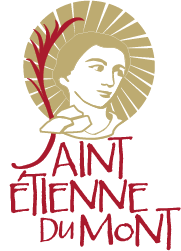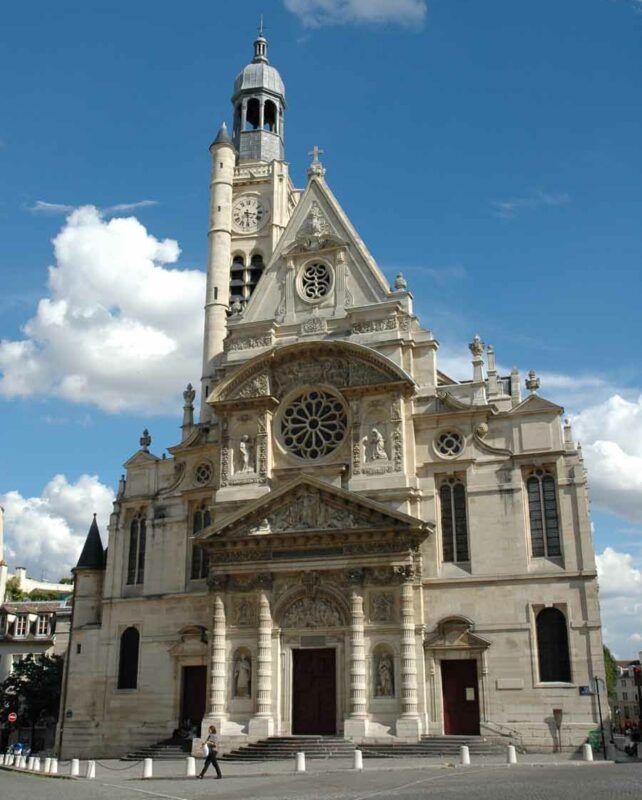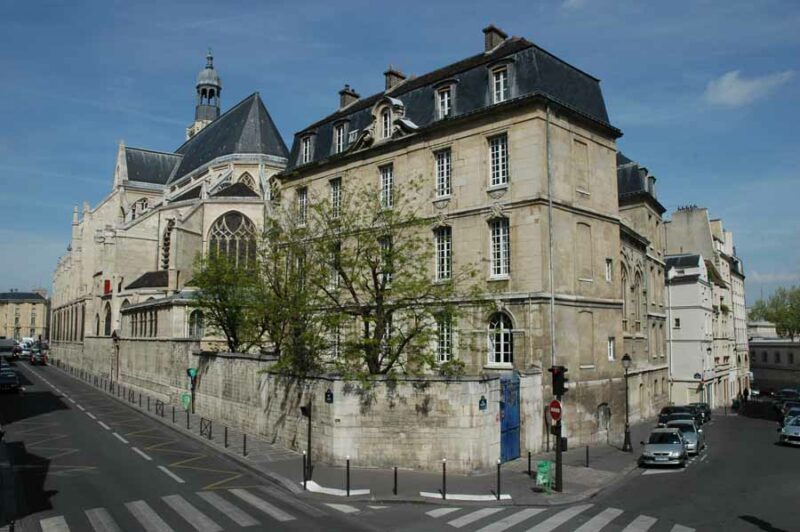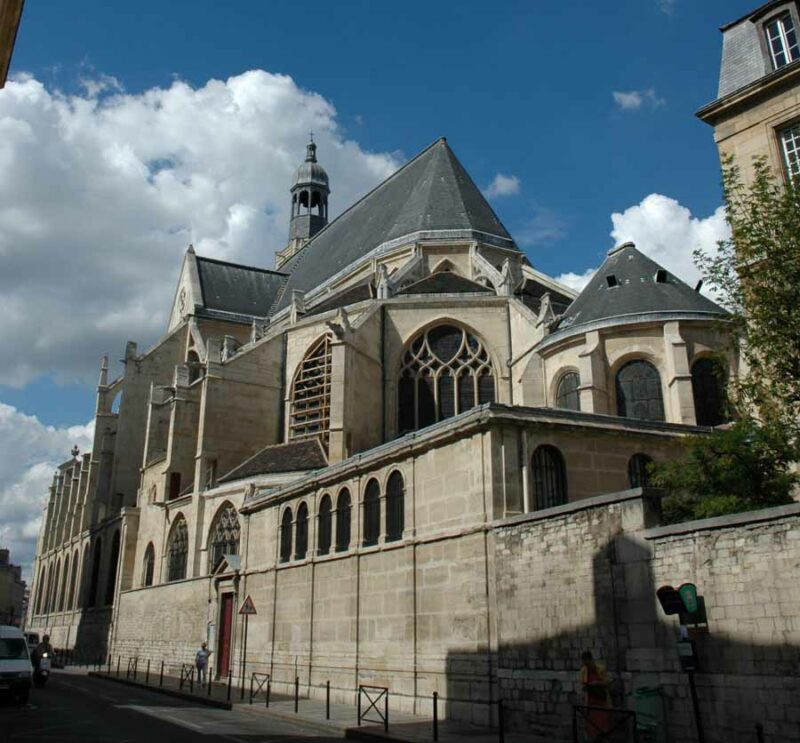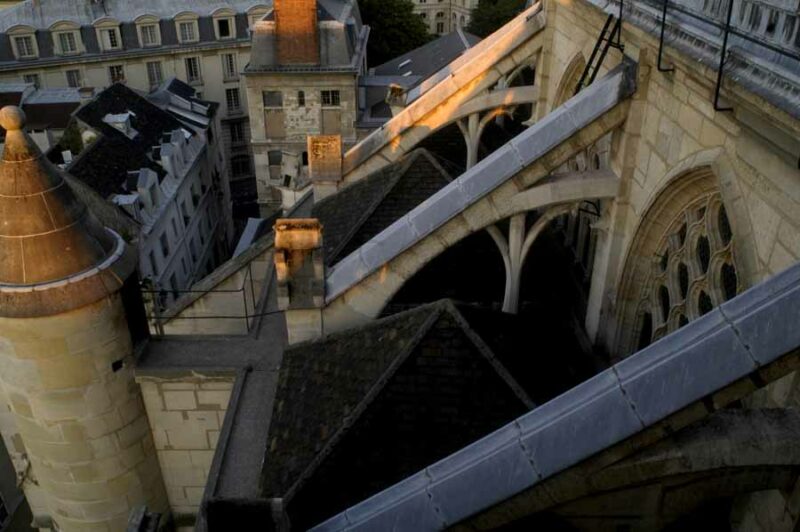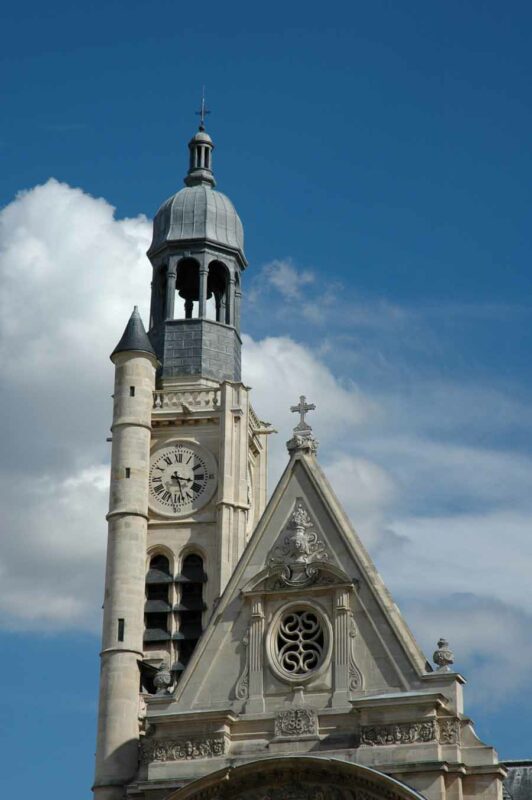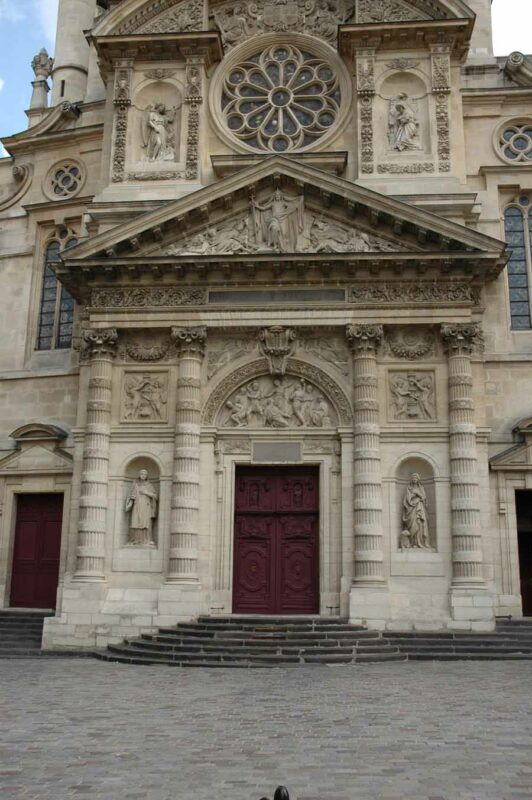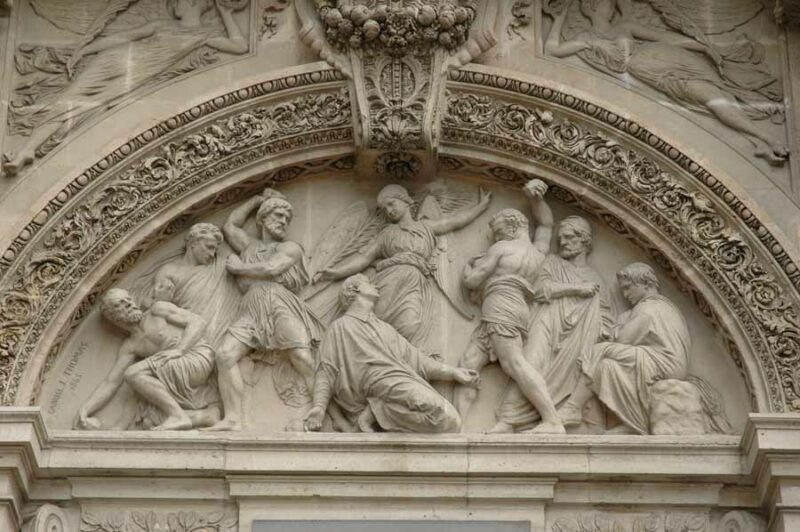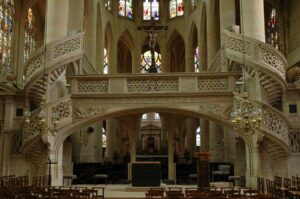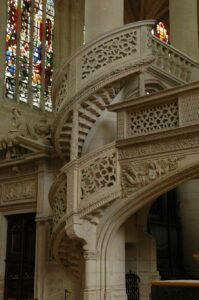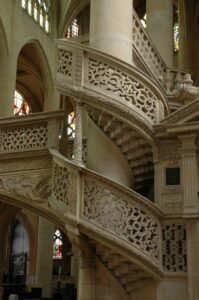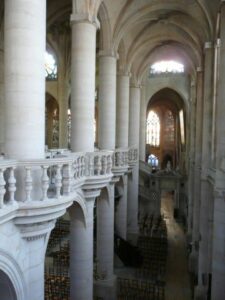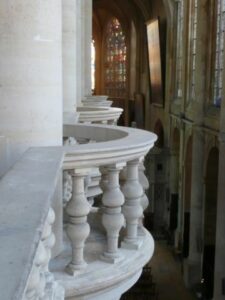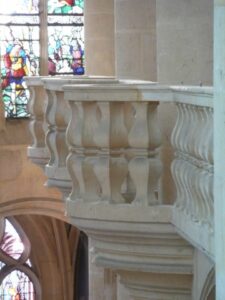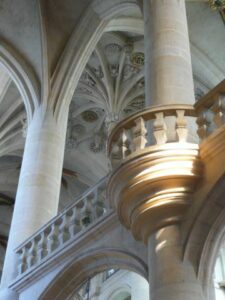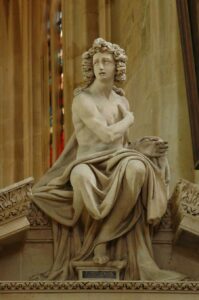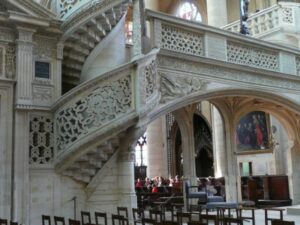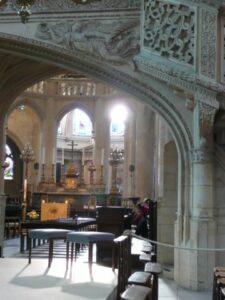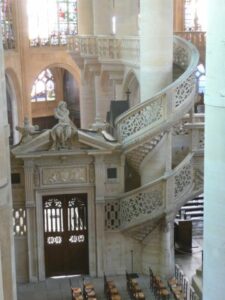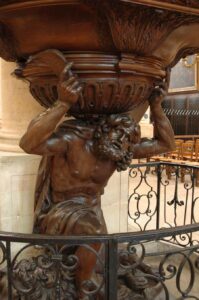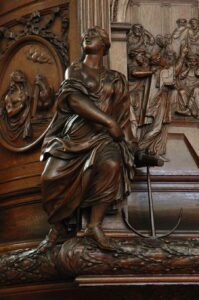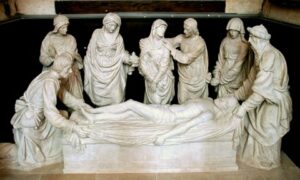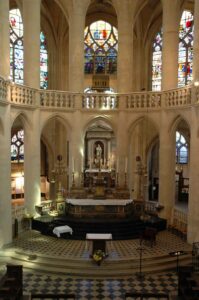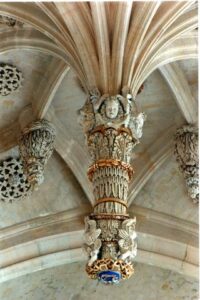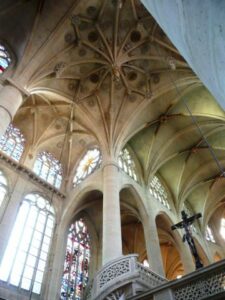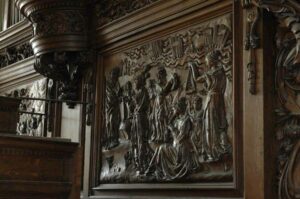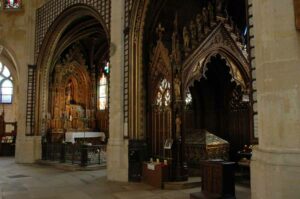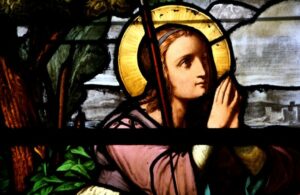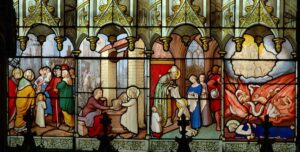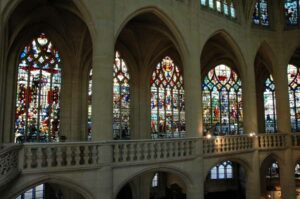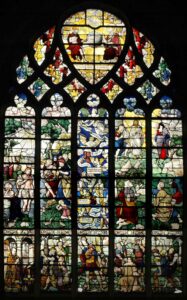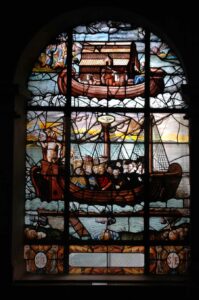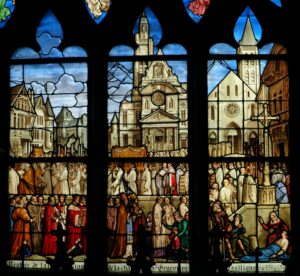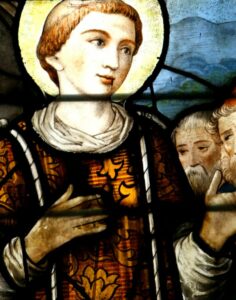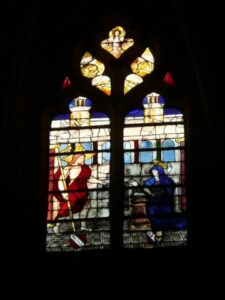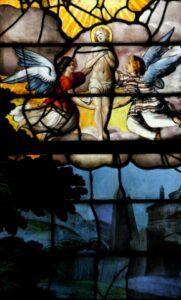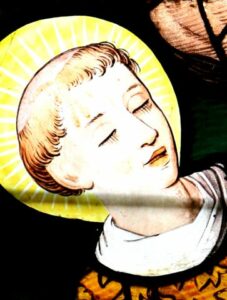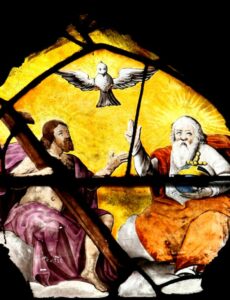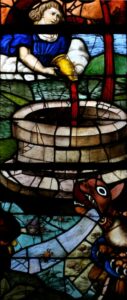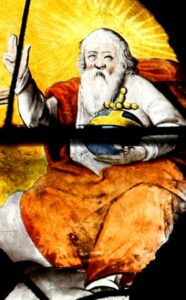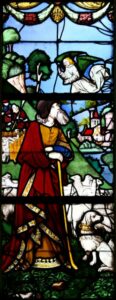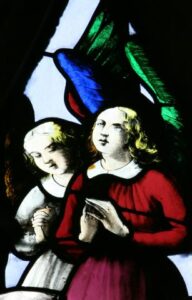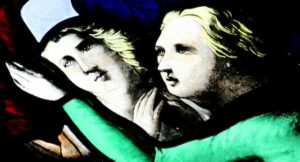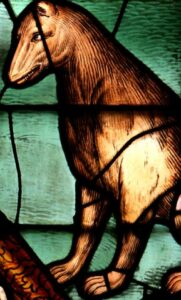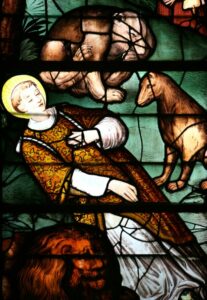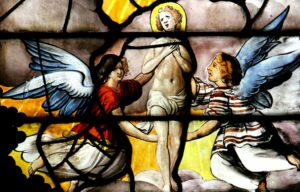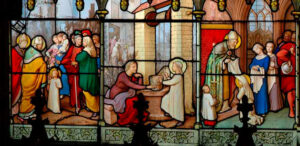Historical account
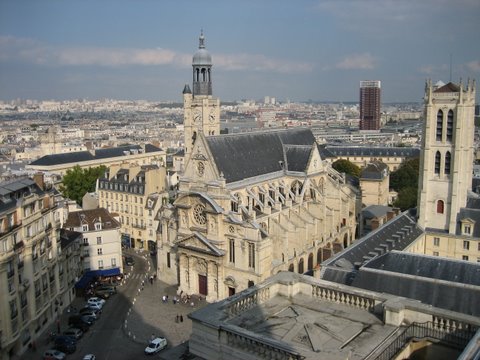
At first, there was the church of Apostles Peter and Paul, built under the reign of King Clovis who was buried here with his wife Clotilde as well as Saint Genevieve. In the Middle Ages, it turned into an important royal abbey under the same name.
During the thirteenth century, the abbey church that hosted the local parish became too small for the growing population, so a second sanctuary was built under the patronage of Saint Stephen, the first martyr. This latter church was eventually rebuilt between 1492 and 1626, in the confused context of the religious wars. The existing Saint-Etienne church was flanking Saint Genevieve abbey.
In 1744, King Louis the Fifteenth decided to replace the abbey church, then in poor condition, by an imposing monument which eventually became, through repeated mishaps, the existing Panthéon. The abbey church was devastated during the French Revolution and the relics of saint Geneviève were burnt. The buildings of the abbey were converted into what is now Henri-IV school and the abbey church was pulled down in 1804 to make room for Rue Clovis ; its only remnant now is the bell-tower, enclosed in the school premises.
Saint-Etienne du Mont then inherited the relics of and the devotion to Saint Genevieve.
On this window (crafted in the nineteenth century) one can recognize the façade of Saint-Etienne-du-Mont church and on its flank, Saint Genevieve church (the bell-tower of which is now Clovis Tower inside Henri-IV school) which the procession is entering.
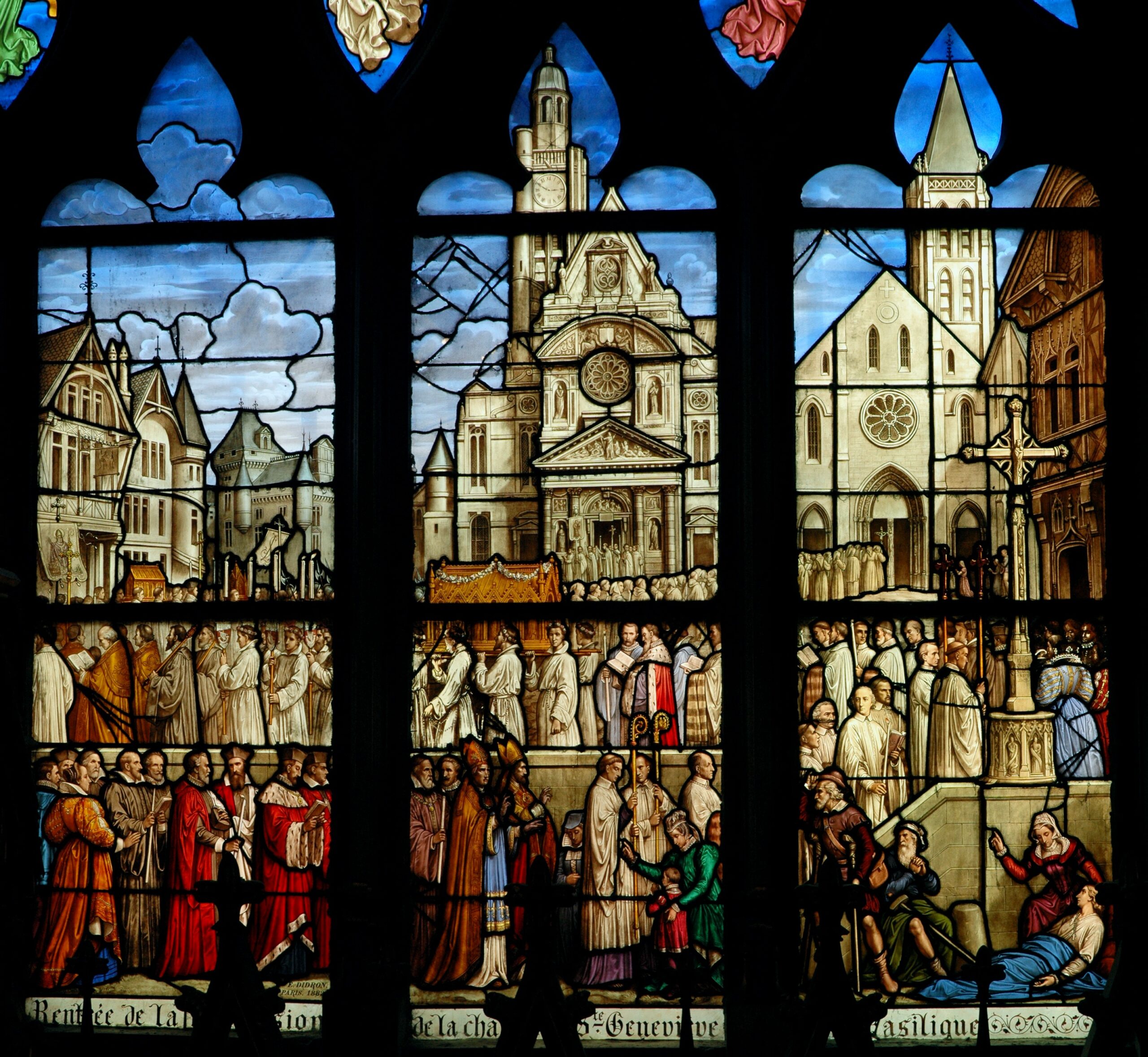
Stained window of Saint Genevieve : the procession for the saint.
Overall and outdoor architecture
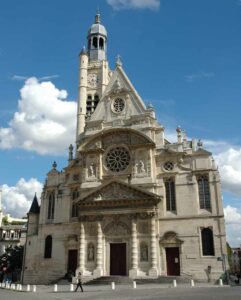
Façade of Saint-Etienne-du-Mont church
Built in the sixteenth century, Saint-Etienne displays a strikingly specific style, unseen elsewhere in Paris, first noticeable in its façade. It is indeed a transition period between the flamboyant gothic style and the Renaissance style inspired by Greek-Roman antiques.
The overall structure is that of a “hall church”, 69 meter long and 25.5 meter wide : the transept does not protrude outwards, the aisles are very high.
The church is slanting leftwards, probably due to the ground’s shape, but the shifts are barely visible.
Inside the building, one can observe the progression in style : on an initial gothic plan, the decoration evolves from pointed arches in the choir to round arches in the nave with a pervasive Renaissance ornamentation. An elegant gallery runs around the church. The keystone summarizes this blending of influences.
Built between 1610 and 1622, the façade is the most noteworthy outdoor feature : a harmonious ensemble in which a Renaissance décor, unique in Paris if not in France, combines itself with a high three-level structure typical of the Middle Ages. At the ground level, the doorway is reminiscent of a Greek temple ; the structure is topped by a high gothic pinnacle.
This façade was restored in the nineteenth century by architect Victor Baltard who rebuilt the statues destroyed during the French Revolution.
It is crowned by a high bell-tower.
The church was completed by the chapel of the Virgin, at the end along the central axis, built in 1653 in Classical style. Flanking the apse, a three-sided cloister built between 1605 and 1609 enclosed a small cemetery.
Beyond the apse, a lovely “hotel particulier” (town house) was built by Louis d’Orléans, the Regent’s son, who dwelt there. It is currently the parish presbytry.
Photo gallery
Indoor architecture
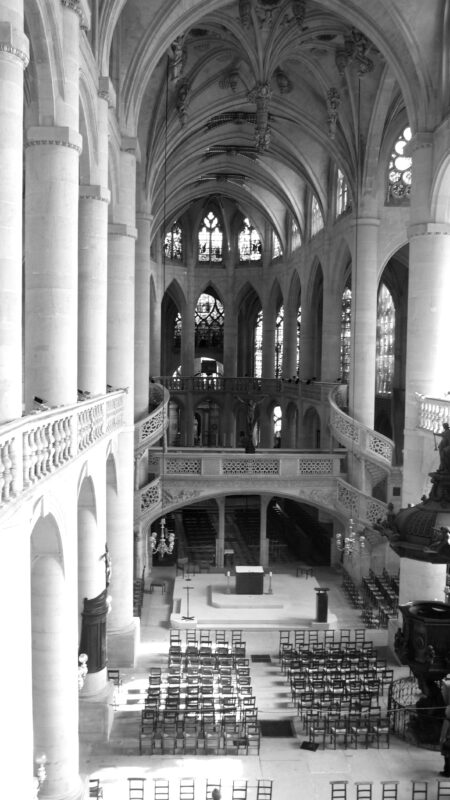
A noticeable item in the church, this choir screen built in the first years of the sixteenth century is the only one still visible in Paris.
In the Middle Ages, the choir screen is both a gate separating the choir where monks and canons stand from the nave where lay persons attend, and a gallery from which is proclaimed the Holy Word (hence its French name “jubé”, first word of the Latin prayer by which the lecturer requests the priest’s blessing : «jube, domine, benedicere…» : “Please, Lord, bless me…”).
In order to make the liturgy visible to the whole congregation, most choir screens were dismantled in the eighteenth century.
This choir screen combines a gothic structure and a fully-fledged Renaissance decoration. The railing is a twining of stone lace, carved in a limestone from Saint-Leu.
Two openwork staircases coil themselves around the pillars, leading both to the choir screen and the gallery, the purpose of which, if not for decoration, is unclear.
Although we have kept records of almost all the craftsmen who took part in the building, oddly we do not know who designed this masterpiece.
The beautiful Christ on the cross which hangs on top of the choir screen, carved by Ulrich von Grienewald, is a remnant of the chapel of the nearby Ecole Polytechnique, dismantled in 1830.
The choir screen and the keystone are a beautiful setting for the contemporary altar designed by the French company Cheret.
Before the French Revolution in 1789, the church owned a rich collection of paintings and tapestries which was thoroughly scattered. As such, all existing artworks result in reconstitutions. Two outstanding paintings are ex-votos to Saint Genevieve, by Nicolas de Largillière (1696) and Jean-François de Troy (1726).
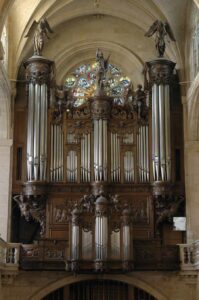
L'orgue - The organ
The organ case was assembled and carved in 1631 by Jehan Buron, master-joiner. It is the oldest one in Paris, still in its original state.
Only some of the 7,000 pipes, ranging from 3 mm to 5.5 m high, are visible. Arranged in 90 stops, it is ranked as the fifth organ in Paris.
Among organ makers who worked in Saint-Etienne-du-Mont, we can mention : Pierre Pescheur, designer of the original instrument of which nothing remains, François-Henri Cliquot (1772), and Cavaillé Coll (1863).
This instrument had many well-known players such as Maurice Duruflé. Born in 1902, he had tenure from age 28 until his death in 1986.
The current holder is Thierry Escaich, winner of the 2002 and 2006 “Victoire de la Musique” awards, and Vincent Warnier.
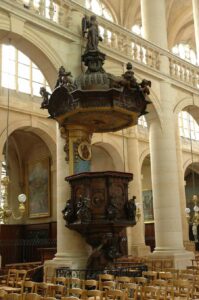 The pulpit, carved in 1651, replaced the choir screen as the preaching point. It is a fine example of baroque art with its emphatic features. Sculptures are by Lestocard who based himself on drawings by La Hire.
The pulpit, carved in 1651, replaced the choir screen as the preaching point. It is a fine example of baroque art with its emphatic features. Sculptures are by Lestocard who based himself on drawings by La Hire.
The barrel is upheld by a mighty figure of Samson ; seven feminine figures around the barrel, inspired from classical models, symbolize cardinal and theological virtues.
The panels around the pulpit tell Saint Stephen’s story, alternating with ovals displaying the four Evangelists and two great Doctors of the Church, saint Hieronymus and saint Augustine.
As the relics of the saint were burnt during the French Revolution by the town officials, and the shrine was melted down, the church houses (since the beginning of the nineteenth century) relics of the saint that had been stored in other churches since the ninth century. The existing great shrine contains the remaining stones of the initial sarcophagus where her body had been laid.
Built in 1853, the chapel is a good example of neo-gothic style. The stained-glasses (1869) tell the story of the saint whose memory is still revived : every year from January 3 to 11, Saint Genevieve’s novena (Latin for “9 days”) celebrates her memory.
Photo gallery
The stained windows
Saint-Etienne owns one of the most comprehensive sets of stained glasses in Paris. It covers the period from the beginning of the sixteenth century to the first quarter of the seventeenth century, after which the art of stained glass falls into a long period of obscurity until the twentieth century. Is is worth noticing that almost all windows are in their original location. At each period, the best craftsmen played a part in them.
Created at the same moment when this part of the building was erected, the windows in the ambulatory give evidence of a willingness to ornate the church immediately. Notice the window of the Most Holy Name of Jesus.
(the charnel in question is a former cemetery)
The stained windows of this gallery were designed at the beginning of the seventeenth century ; half of the initial 24 still remain. These are painting on glass with enamels fired in the oven, unlike all other windows of the church, in which glass has been molten with coloured pigments in it.
They share a common theme : the Eucharist, or real presence of resuscitated Christ in the consecrated bread, and its fore figures in the Old Testament. Among them, the “Mystical Wine-press” enacts Christ’s words during the Last Supper, which the Catholic liturgy repeats during every office, when he passed the cup of wine saying “this is my blood”.
Photo gallery
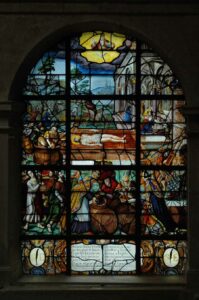
Famous characters
The church maintains the memory of several famous characters.
French philosopher Blaise Pascal (1623-1662) is buried in Saint-Etienne-du-Mont because he passed away on the parish premises.
The remains of French playwright Jean Racine (1639-1699) were brought here after the dismantling of jansenist-oriented Port-Royal des Champs abbey because his family lived in the area. Besides, Saint-Etienne was a parish with strong jansenist connections.
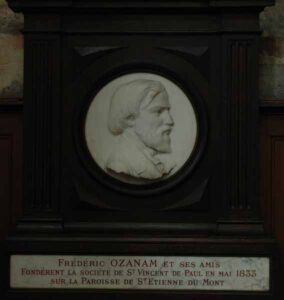
Médaillon à l’effigie de Frédéric Ozanam
A young student born in Lyon, he founded the Saint-Vincent-de-Paul Society with some friends in 1833, and chose this parish (then one of the poorest in Paris) to gather the first conference of the Society.
Both a lay charity and a missionary society, its action predates social Catholicism such as Pope Leon XIII defined it in its “Rerum Novarum” encyclical letter (1891).
Now the organization has an international reach, with 850 000 members in 116 countries on all 5 continents (of which 30 000 members in France). [more (in French) on the Society’s website]
Pope John Paul II beatified Frédéric Ozanam in Saint-Etienne-du-Mont church on August 22, 1997, on the occasion of World Youth Days.
A real life visit is even more enjoyable !
When on the spot, you can get a copy of the pamphlet designed by the “Art, Culture et Foi” association, the text of which was used to write these pages.
English version kindly performed by Mr Wronecki, and Mr & Mrs McNulty.
